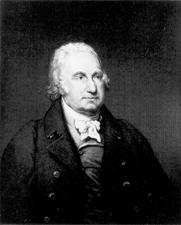John E. Howard
|
|
John Eager Howard (June 4, 1752 - October 12, 1827) was a American politician from Maryland. He was born in and died in Baltimore County. Howard County, Maryland is named for him.
Howard was of the Episcopalian religion, and a Brother of a Baltimore lodge of Freemasonry. A captain who rose to the rank of colonel in the Continental Army, he fought at the Battle of White Plains and in the Monmouth campaign. He was awarded a silver medal by Congress for his leadership at the Battle of Cowpens, during which he commanded the Third Maryland Regiment.
Following his army service, he held several political positions: member of the Continental Congress of 1788; Governor of Maryland for one term, 1789 through 1791; State Senator from 1791 through 1795; Presidential Elector in 1792; thereafter he joined the Federalist Party and served in the 4th Congress from November 30, 1796 through 1797 as a United States Senator for the remainder of the term of Richard Potts, who had resigned; and was elected for a Senate term of his own in 1797, which included the 5th Congress, the 6th Congress of 1799-1801 during which he was President pro tempore, and the 7th Congress, serving until March 3, 1803. In 1816, he ran with Rufus King as the Vice Presidential candidate of the Federalist Party, but lost his home state and received only the 22 electoral votes of Massachusetts, losing to James Monroe and Governor Daniel Tompkins.
Although he was offered the Secretaryship of War in the Administration of President George Washington, he declined it, as well as a 1798 commission to Brigadier General during the preparations for the coming war with the new French republic.
His son, George Howard was born in Jennings House during his term as Governor; George eventually returned there as Governor himself forty years after his father's term, and four years after his death. His son Benjamin Chew Howard was also a prominent politician in Maryland, serving four terms in the U.S. Congress.
John Eager Howard is buried at the Old Saint Paul's Cemetery, in Baltimore.
External links
Some information derived from, and thanks due to:
- The Political Graveyard (http://politicalgraveyard.com/) (entry (http://politicalgraveyard.com/bio/howard.html#R9M0J14KU));
- Congressional Biographical Directory (http://bioguide.congress.gov/) (entry (http://bioguide.congress.gov/scripts/biodisplay.pl?index=H000841)).
- Phoenixmasonry, Inc. (http://www.phoenixmasonry.org/) (The Builder Magazine, THE STORY OF "OLD GLORY"--THE OLDEST FLAG (http://www.phoenixmasonry.org/the_builder_1916_october.htm)).
Portraits of John Eager Howard:
- A portrait in the City of Philadelphia collection (http://www.cr.nps.gov/museum/exhibits/revwar/image_gal/indeimg/howard.html);
- A portrait in the Maryland State Archives collection (http://www.mdarchives.state.md.us/msa/speccol/sc1500/sc1545/e_catalogue/html/objects/1545_1053.html);
- A second portrait in the Maryland State Archives collection (http://www.mdarchives.state.md.us/msa/speccol/sc3500/sc3520/000600/000692/html/msa00692.html).
Further biographical information:
- Famous Americans biography (http://www.famousamericans.net/johneagerhoward/).
| Preceded by: William Smallwood | Governor of Maryland 1788—1791 | Succeeded by: George Plater |
| Preceded by: Richard Potts | Class 1 U.S. Senator from Maryland 1796—1803 | Succeeded by: Samuel Smith |
| Preceded by: Jared Ingersoll | Federalist Party Vice Presidential candidate 1816 (lost) | Succeeded by: (none) |

